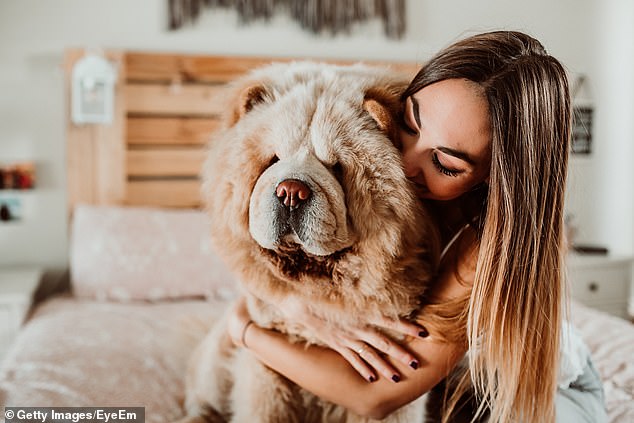Dogs are described as ‘mans best friend’ but that close-relationship is more to do with how women treated them with affection and named them, a study finds.
Washington State University researchers searched extensive collections of writings by anthropologists on traditional, subsistence-level societies around the world.
The team discovered a pattern in traditional societies where women were more involved with dogs – humans became more useful to canines.
In traditional societies – which act as a mirror for early human history – the more a woman is involved in the care of a dog, the more it becomes ‘part of the family’ – including having a name and sleeping in its owners bed, the authors discovered.
‘We found that dogs’ relationships with women might have had a greater impact on the dog-human bond than relationships with men,’ said author Jaime Chambers.
Several factors went into forming the relationship between dog and human including temperature, hunting and most surprisingly – gender. Stock image
While dogs are the oldest, most widespread domesticated animal, very few anthropologic studies have directly focused on the human relationship with canines.
This is part of what prompted the US team to search through the ‘Human Relations Area Files’ database – an extensive collection of ethnographic documents.
Chambers and colleagues found thousands of mentions of dogs in over 844 pieces of writing on 144 traditional, subsistence-level societies from around the world.
Looking at these cultures can provide insight into how the dog-human relationship developed, Chambers said, as they give an insight into early human societies.

In traditional societies – which act as a mirror for early human history – the more a woman is involved in the care of a dog, the more it becomes ‘part of the family’ – including having a name and sleeping in its owners bed, the authors discovered. Stock image
‘Our modern society is like a blip in the timeline of human history,’ Chambers said, adding that the dog-human relationships looked different in the past to the way they are in modern, Western industrialised societies.
Through the documents and writings on these traditional societies, they found references to dogs’ utility or usefulness to humans.
They also found evidence of the ‘personhood’ of dogs, which is where canines are treated like people – given names, allowed to sleep in some bed and mourned.
The team discovered a pattern in traditional societies where women were more involved with dogs – humans became more useful to canines.
This was shown through a greater degree of affection – their ‘personhood’ increased – they were more likely to be given a name or sleep in their owners bed.
Another prevalent trend involved the environment: the warmer the overall climate, the less useful dogs tended to be to humans.
‘Relative to humans, dogs are really not particularly energy efficient,’ said Robert Quinlan, WSU anthropology professor and corresponding author on the paper.
‘Their body temperature is higher than humans, and just a bit of exercise can make them overheat on a hot day,’ he explained.
‘We saw this trend that they had less utility to humans in warmer environments,’ with a few dog-loving cultures in the tropics acting as a rare exception to the trend.
Another discovery made by the team was that hunting also strengthened the relationship between humans and dogs.
Those cultures that hunt with dogs valued their canines more highly than others who don’t use a dog to help track down prey.
They were higher both in the dogs’ utility to humans and in their ‘personhood’ – their likelihood of being given a name and allowed to sleep in a human bed.
As a society started to grow more crops, keep livestock and produce food the culture began to value a dog’s utility and personhood less than when hunting.
This finding seemed to go against the commonly held perception of herding dogs working in concert with humans, but Quinlan noted that in many cultures, herding dogs often work alone whereas hunting requires a more intense cooperation.
Chambers and Quinlan say their research adds evidence to the theory that dogs and humans ‘chose each other’ rather than humans seeking out wolf pups to raise.
‘Either way, there have been clear benefits for the dogs’, Chambers said, adding that ‘dogs are everywhere humans are.’
‘If we think that dogs are successful as a species if there are lots of them, then they have been able to thrive. They have hitched themselves to us and followed us all over the world. It’s been a very successful relationship.’
The findings have been published in the Journal of Ethnobiology.
